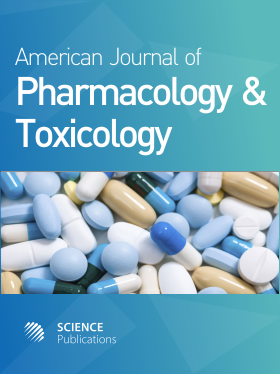Slow Fungal Hydrolysis of Complex Sugar is Responsible for the Use of Sugar as Vehicle for Antifungal Drugs
- 1 Federal University of Technology, Nigeria
- 2 Nnamdi Azikiwe University, Nigeria
- 3 Veterinary Research Institute, Nigeria
- 4 Jos University Teaching Hospital, Nigeria
Abstract
Problem statement: Aspergillus niger strain (UUF 9202) significantly reduced the dormancy period and boosted aggregate germination time in seeds of Tetrapleura tetraptera by 42% in 32 days and produced a net reduction in mean germination time of the seeds to 12 days. A structure-fungitoxicity relationship study of a series of isoflavonoids against Aspergillus niger and Cladosporium cucumerinum showed that a high level of lipophilicity and the presence of at least one phenolic function appear important for isoflavonoid fungitoxicity. Amphotericin B, the best drug for deep or systemic infections is not active orally and as such is administered intra venously. The two intravenous formulations of amphotericin B include a complex of amphotericin B and Deoxycholate (DOC) and a Small Unilamella Vesicle containing (SUV) amphotericin B combined with 350 mg of lipid in Soy lecithin; cholesterol and distearoylphosphatidylglycerol. Approach: A study found that dispersion in concentrated sugar solution provided a better vehicle for marked antifungal effect of Eucalyptus camaldensis than distilled water eventhough both the sugar solution extract and the distilled water extract had equal antifungal activity against clinical dermatophyte isolates of Microsporium gypseum and Trichophyton mentagrophytes (P = 0.05). This study hydrolysed cassava starch, through the action of isolated alpha and beta-amylase enzymes on the one hand and through the action of Aspergillus niger fungal cells on the other; to find out why lipids and complex carbohydrates are the best vehicles of antifungal drugs and plant extracts. Results: The results of the study showed that α and β amylase enzymes hydrolysed gelatinized starch in 1 h while Aspergillus niger hydrolysed the same quantity of gelatinized starch in 72 h under the same conditions. These results show that Aspergillus niger hydrolyses complex carbohydrates (high calorie foods) very slowly. The findings of the study suggest that complex carbohydrates like the starch in this study; the concentrated sugar solution in the Eucalyptus camaldensis study and the soy lipid/cholesterol in amphotericin B SUV formulation; present antifungal drugs effectively for antifungal activity on fungal infections because fungal organisms take days to slowly hydrolyse such complex carbohydrate foods (high calorie foods) as has been demonstrated by the 3 days hydrolysis of gelatinized (cooked) starch by Aspergillus Niger. It is this slow hydrolysis of the cellulose of the seed coat of Tetrap [eura tetraptera by Aspergillus niger (strain UUF 9202) that significantly reduced the dormancy period; bosted aggregate germination time of the seeds by 42% in 32 days and reduced the mean germination of the seeds to 12 days in a situation in which seeds soaked in pre-sterised Aspergillus niger spore suspension at 30°C gave zero germination. The findings of this study suggest that Aspergillus niger hydrolysis of starch at room temperature engages the Aspergillus niger cells fully for a long period of three days which constitutes feeding on the starch for its own energy generation. While the Aspergillus niger cells are engaged in the 3-day hydrolysis of a complex carbohydrate vehicle of an antifungal drug, the drug simultaneously engages in the elimination of the fungi. Conclusion: These findings therefore suggest that slow speed hydrolysis of complex carbohydrates in the host body for its own food is a major mechanism of Aspergillus niger (and other fungi) infectivity of their human and other hosts. Reduction of complex carbohydrate intake is thus hereby identified as an important factor in the control of fungal infections. Also for antifungal herbal extracts and other antifungal drugs that do not need to be presented to infective fungi by complex carbohydrates, their activity will be enhanced by concurrent reduction of complex carbohydrate intake which will thus result in eradication of the fungal infection in question.
DOI: https://doi.org/10.3844/ajptsp.2011.80.83

- 4,740 Views
- 3,863 Downloads
- 0 Citations
Download
Keywords
- Antifungal activity
- antifungal drugs
- complex carbohydrates
- fungal infection
- Aspergillus niger
- antifungal herbal
- major mechanism
- antifungal drug
- calorie foods
